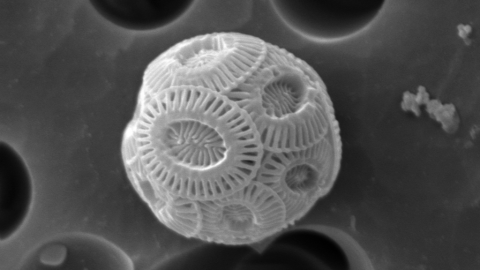Why is it important?
The ocean is taking up some of the carbon dioxide (CO2) emissions from human activities from the atmosphere. This uptake of CO2 by the ocean leads to a chemical reaction, within the seawater, in which hydrogen ions are released resulting in a decrease in pH. This results in an increase in acidity (lower pH) of the seawater and is called ocean acidification. To date, it is estimated the global ocean has taken up between 20 and 30 % of the total anthropogenic emissions since the 1980s (Pörtner et al., 2019).
This increased ocean acidity will have an impact on marine organisms and habitats, especially those that build skeletons from calcium carbonate (CaCO3) such as shellfish and some plankton species. This impact on CaCO3 is associated with the decrease of pH, as the carbonate ions (such as calcite and aragonite) react with the excess hydrogen to form bicarbonate ions and reduces their availability to marine organisms. Understanding of these impacts, particularly on a regional scale, is still developing.
The ocean’s pH is influenced by a number of physical and biological processes, including temperature and primary productivity (Humphreys et al., 2020). In temperate seas, such as the North Sea. The role of primary production leads (in temperate and polar regions) to an uptake of CO2 from the atmosphere in the spring and summer, and a balance between ocean and atmosphere or release from the ocean in winter-time.
What is already happening?
From time series such as that at Stonehaven (see Ocean acidification assessment), researchers are beginning to understand the natural variability in pH in temperate shelf seas. Longer time series are needed to enable the long term anthropogenic ocean acidification signal to be distinguished from this natural variability.
Thomas, Bozec, Elkalay & De Baar (2004) estimated that the highest rates of CO2 uptake in the northern North Sea occur in the East Shetland Shelf and Fladen and Moray Firth Offshore regions. Due to the seasonal stratification in these areas, the CO2 that is taken up by phytoplankton during photosynthesis and by shell-forming organisms, is exported to the near-bed layer where it is part of the exchange of waters between the North Sea and North Atlantic Ocean. This is also referred to as the continental shelf pump.
In many regions around the world, pH is declining with the trend emerging from the natural variability (Pörtner et al., 2019). This includes the Northern North Sea (Omar, Thomas, Olsen, Becker, Skjelvan, & Reverdin, 2019). At Stonehaven, the seasonal range can be as high as 0.3 pH units, although a long-term decrease of 0.02 pH units per year has been observed (Humphreys et al., 2020).
Changes in carbonate chemistry and a decrease in pH may have an impact on those marine organisms that form shells or skeletons from calcium carbonate. Evidence from the Stonehaven monitoring site shows that shell dissolution of pelagic gastropods (sea snails; Limacina spp.) occurred towards winter months, despite aragonite not being limited. This highlights the need to further understand the ocean’s carbonate chemistry and its impact on marine life (see Case study: Coccolithophores at Stonehaven and Case study: Shell integrity of pelagic gastropods at Stonehaven).
What is likely to happen in future?
Climate models predict that the global ocean will continue to take up the excess CO2 from the atmosphere, leading to increased ocean acidification (Pörtner et al., 2019). The aragonite and calcite saturation state are a common measure to track carbonate ion concentration. When saturation state (Ω) is supersaturated, calcium and carbonate ions will combine to form calcite or aragonite. When seawater is undersaturated, the aragonite or calcite minerals would dissolve. Regional climate projections of the UK continental shelf estimate that aragonite undersaturation will likely occur in regions with seasonal stratification, such as the northern North Sea, by the end of the 21st century, with episodic events expected by 2030 and widespread occurrences by the end of the century (Humphreys et al., 2020). This is likely due to differences in biological processes influencing carbonate chemistry between stratified and mixed regions (Artioli et al., 2014).
Although scientists are confident that global mean pH will decrease, there is less confidence in how specifically shallow regional sea such as the North Sea will respond, due to uncertainties in the small-scale processes that are important in these systems.
As in the atmosphere and on land, anthropogenic climate change has an impact on the physical environment of the ocean. Public awareness often emphasises warming ocean temperatures, rising sea-levels and ocean acidification, but the impacts extend further. These include changes to the salinity and oxygen concentration of seawater, the currents, waves, storms, coastlines and water column stratification. This section summarises current knowledge of the impacts of climate change that have already been observed and provides an outlook on how conditions are likely to change in future from climate projections.

Links and resources
|
, 2014. Heterogeneity of impacts of high CO₂ on the North Western European Shelf. Biogeosciences, 11, pp.601–612. Available at: https://bg.copernicus.org/articles/11/601/2014/. |
|
, 2019. Trends of Ocean Acidification and pCO2 in the Northern North Sea, 2003–2015. Journal of Geophysical Research: Biogeosciences, 124(10), pp.3088 - 3103. Available at: https://agupubs.onlinelibrary.wiley.com/doi/10.1029/2018JG004992. |
|
, 2004. Enhanced Open Ocean Storage of CO2 from Shelf Sea Pumping. Science, 304, pp.1005–1008. Available at: https://science.sciencemag.org/content/304/5673/1005. |

